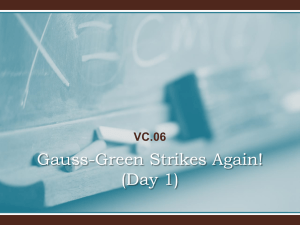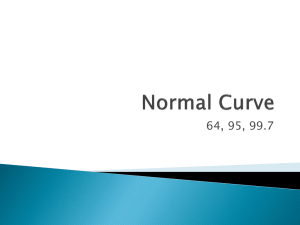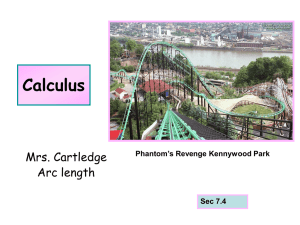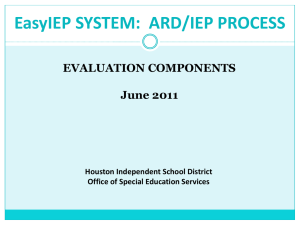Measuring the Flow of a Vector Field ACROSS a Closed Curve
advertisement
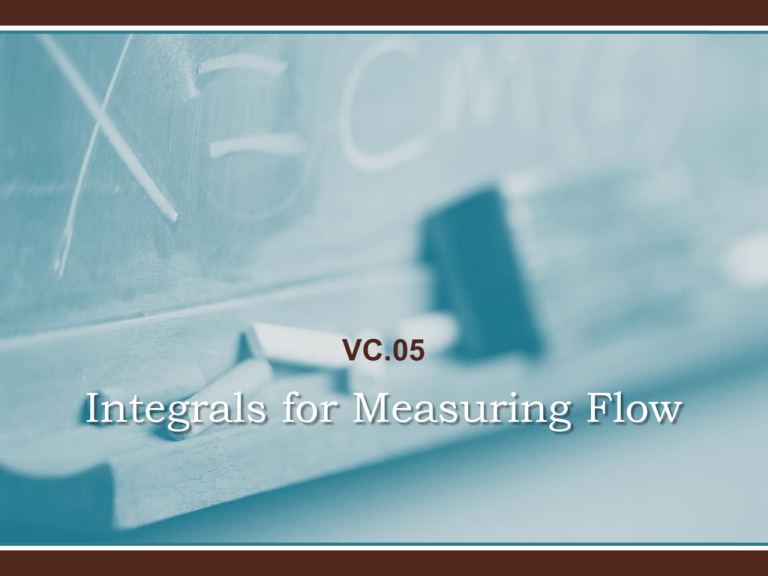
VC.05 Integrals for Measuring Flow Example 1: Measuring the Flow of a Vector Field ALONG a Closed Curve Let Field( x , y ) ( y , 2 x ) b e a vector field a ctin g on th e cu rve E( t ) (cos( t ), 2 sin ( t )) (-1 , 1 ) M easure the flow of the vector field alo ng the curve: R e c all th at th is is lik e a se t o f u n d e rw ate r train trac k s b e in g b u ffe te d b y a sw irlin g , v io le n t c u rre n t. W e can g et a b etter p ictu re o f w h at is g o in g o n b y ju st p lo ttin g th e field vecto rs w h o se tails are o n th e cu rve: Example 1: Measuring the Flow of a Vector Field ALONG a Closed Curve Let Field( x , y ) ( y , 2 x ) b e a vector field a ctin g on th e cu rve E( t ) (cos( t ), 2 sin ( t )) (-1 , 1 ) M easure the flow of the vector field alo ng the curve: C an w e tell if it is clockw ise or cou n terclockw ise yet? H o w d o w e g et a b etter p ictu re o f w h at is g o in g o n b ased o n w h at w e learn ed last ch ap ter? Example 1: Measuring the Flow of a Vector Field ALONG a Closed Curve Let Field( x , y ) ( y , 2 x ) b e a vector field a ctin g on th e cu rve E( t ) (cos( t ), 2 sin ( t )) (-1 , 1 ) M easure the flow of the vector field alo ng the curve: Y es, at each p o in t, w e can p lo t th e p u sh o f th e field vecto r in th e d irectio n o f th e tan g en t vecto r to th e cu rve: Fie ld( x( t ), y( t )) ( x '( t ), y '( t )) ( x '( t ), y '( t )) ( x '( t ), y '( t )) ( x '( t ), y '( t )) It lo o ks like it is a n et co u n terclo ckw is e flo w o f th e vecto r field alo n g th e cu rve , b u t are w e 100% p o sitive ab o u t th is? Example 1: Measuring the Flow of a Vector Field ALONG a Closed Curve Let Field( x , y ) ( y , 2 x ) b e a vector field a ctin g on th e cu rve E( t ) (cos( t ), 2 sin ( t )) (-1 , 1 ) M easure the flow of the vector field alo ng the curve: O u r re al m e asu re is re ally w h at h ap p e n s to Fie ld( x ( t ), y( t )) ( x '( t ), y '( t )) aro u n d th e c u rv e sin c e th is re c o rd s w h e n th e fie ld h e lp s o r h u rts o u r m o v e m e n t in th e d ire c tio n o f th e p aram e te riz atio n , an d b y h o w m u c h : In te g rate it : 2 Fie ld( x( t ), y( t )) ( x '( t ), y '( t )) d t 0 Example 1: Measuring the Flow of a Vector Field ALONG a Closed Curve Let Field( x , y ) ( y , 2 x ) b e a vector field a ctin g on th e cu rve E( t ) (cos( t ), 2 sin ( t )) (-1 , 1 ) M easure the flow of the vector field alo ng the curve: 2 Fie ld( x ( t ), y( t )) ( x '( t ), y '( t )) d t 0 2 (2 sin ( t ) 1 , 2 co s( t ) 2 ) ( sin ( t ), 2 co s( t )) d t 0 2 2 2 2 sin ( t ) sin ( t ) 4 c o s ( t ) 4 c o s( t ) d t 0 2 Positive ! T h e n et flow of th e vector field alon g th e cu rve is in th e d irection of th e p aram eterization (cou n terclockw ise). The Line Integral: Formalizing What We Just Did S o fa r, w e o n ly in te g ra te d b e c a u se w e h a d a v a g u e n o tio n th a t in te g ra tin g th is e x p re ssio n w ill a c c u m u l a te a ll o f th e little p u sh e s w ith o r a g a in st th e c u rv e a n d te ll u s w h e th e r w e h a v e a n e t p u sh in th e c lo c k w ise o r c o u n te rc lo c k w ise d ire c tio n . W e c a n d o b e tte r: b f( x ) d x a F( x , y ) d c C o Fu n c tio n o f a sin g le v ariab le o T w o -c o m p o n e n t v e c to r fie ld , F(x ,y) o In te rv al [a,b ] alo n g th e x -ax is o C u rv e in sp ac e , C , w ith p aram e te riz atio n c o In te g rate w ith re sp e c t to o In te g rate w ith re sp e c t to m o v e m e n t alo n g le ft-rig h t (x ) m o v e m e n t: d x th e p aram e te riz atio n o f th e c u rv e : d c o f( x ) " tim e s " d x o F( x , y ) " d o t p ro d u c t " d c The Line Integral: Formalizing What We Just Did Let C b e a cu rve p aram eterized b y c(t)= ( x(t),y(t)) an d let F(x,y) b e a vector field , sh ort for Field (x,y)= m ( x , y ), n( x , y ) . b F( x , y ) d c F( x( t ), y( t )) C a dc dt dt b F( x ( t ), y( t )) c '( t )d t a b Fie ld( x ( t ), y( t )) ( x '( t ), y '( t ))d t a This is called the line integral of the vector field along the curve. Other Ways Of Writing The Line Integral Let Field( x , y ) m ( x , y ), n( x , y ) an d let C b e a c u rve p aram eterized b y (x(t),y(t)). a Fie ld( x( t ), y( t )) ( x '( t ), y '( t ))d t b m ( x ( t ), y( t )), n( x ( t ), y( t )) ( x '( t ), y '( t ))d t a b m ( x ( t ), y( t ))x '( t ) n( x ( t ), y( t ))y '( t ) d t a b m ( x( t ), y( t )) d t d t n( x( t ), y( t )) d t d t a b dx m ( x , y )d x n( x , y )d y C dy Put it All Together: Measuring the Flow of a Vector Field ALONG a Curve If C is a closed curve with a counterclockwise parameterization: In te g ral : If C is not closed: In te g ral : b b Fie ld( x( t ), y( t )) ( x '( t ), y '( t ))d t Fie ld( x( t ), y( t )) ( x '( t ), y '( t ))d t a a b b m ( x( t ), y( t ))x '( t ) n( x( t ), y( t ))y '( t ) d t a Ñ C m ( x , y )d x n( x , y )d y These integrals are used to compute net flow of the vector field along the closed curve (clockwise or counterwise). They can be modified to measure flow of the vector field across the closed curve (inside to outside or outside to inside) with relative ease. m ( x( t ), y( t ))x '( t ) n( x( t ), y( t ))y '( t ) d t a m ( x , y )d x n( x , y )d y C Without a closed curve, the integral is measured whether the net flow along the open curve is in the direction of parameterization or against it, and whether the net flow across the open curve is from “above to below” or “below to above.” These integrals are usually called line integrals or path integrals. Put it All Together: Measuring the Flow of a Vector Field ALONG a Curve Let C be a closed curve w ith a CO UN TERCLO CK W ISE param eterization : Ñ C m ( x , y )d x n( x , y )d y 0 d e scrib e s a n e t flo w o f th e v e cto r fie ld alo n g th e cu rv e in th e co u n te rclo ck w ise d ire ctio n . Ñ C m ( x , y )d x n( x , y )d y 0 d e scrib e s a n e t flo w o f th e v e cto r fie ld alo n g th e cu rv e in th e clo ck w ise d ire cti o n . Ñ C m ( x , y )d x n( x , y )d y can eq u al 0. Example 2: Measuring the Flow of a Vector Field Along Another Closed Curve 2 x1 2 Le t Fie ld( x , y ) (3 y , x ) b e a v e cto r fie ld a ctin g o n th e e llip se y 1 . C o m p u te 2 2 Ñ C m ( x , y )d x n( x , y )d y : C o m p o n e n t o f Fie ld V e cto rs in th e D ire ctio n o f th e Field an d C u rve : V ectors on Curve : T an g e n t V e cto rs Example 2: Measuring the Flow of a Vector Field Along Another Closed Curve 2 L e t Fie ld( x , y ) (3 y , x ) b e a v e cto r fie ld a ctin g o n th e 2 x1 2 e llip se y 1 . C o m p u te 2 Ñ C m ( x , y )d x n( x , y )d y : Counterclockwise Fie ld( x , y ) m ( x , y ), n( x , y ) (3 y , x ) E( t ) ( 2 c o s( t ), sin ( t )) (1 , 0 ) 2 b Ñ C m( x , y )d x n( x , y )d y m ( x ( t ), y( t ))x '( t ) n( x ( t ), y( t ))y '( t ) d t a 2 2 3 2 co s( t ) 4 co s ( t ) 4 co s ( t ) 6 si n ( t ) d t 0 10 N eg ative ! T h e n et flow of th e vector field alon g th e cu rve is ag ain st th e d irection of th e p aram eteriz ation ( clockw ise). Example 3: Measuring the Flow of a Vector Field ACROSS a Closed Curve Let Field( x , y ) ( y , x y ) b e a vector field a ctin g on th e cu rve E( t ) (cos( t ), 2 sin ( t )) (2, 0 ) M e asu re th e flo w o f th e ve cto r fie ld acr o ss th e cu rve : W e can g et a b etter p ictu re o f w h at is g o in g o n b y ju st p lo ttin g th e field vecto rs w h o se tails are o n th e cu rve: Example 3: Measuring the Flow of a Vector Field ACROSS a Closed Curve Let Field( x , y ) ( y , x y ) b e a vector field a ctin g on th e cu rve E( t ) (cos( t ), 2 sin ( t )) (2, 0 ) M e asu re th e flo w o f th e v e cto r fie ld acr o ss th e cu rv e : B e tte r, b u t w e c a n im p ro v e o u r p ic tu re fu rth e r: Example 3: Measuring the Flow of a Vector Field ACROSS a Closed Curve Let Field( x , y ) ( y , x y ) b e a vector field a ctin g on th e cu rve E( t ) (cos( t ), 2 sin ( t )) (2, 0 ) M e asu re th e flo w o f th e ve cto r fie ld acr o ss th e cu rve : A t each p o in t, w e can p lo t th e p u sh o f th e field vecto r in th e d irectio n o f th e n o rm al vecto r to th e cu rve: Fie ld( x( t ), y( t )) ( y '( t ), x '( t )) ( y '( t ), x '( t )) ( y '( t ), x '( t )) ( y '( t ), x '( t )) It lo o k s lik e it is a n e t flo w o f th e v e c to r fie ld a c ro ss th e c u rv e fro m in sid e to o u tsid e , b u t w e w a n t to v e rify th is n u m e ric a lly : Example 3: Measuring the Flow of a Vector Field ACROSS a Closed Curve Let Field( x , y ) ( y , x y ) b e a vector field a ctin g on th e cu rve E( t ) (cos( t ), 2 sin ( t )) (2, 0 ) M e asu re th e flo w o f th e ve cto r fie ld acr o ss th e cu rve : O u r re al m e asu re is re ally w h at h ap p e n s to Fie ld( x ( t ), y( t )) ( y '( t ), x '( t )) aro u n d th e c u rv e sin c e th is re c o rd s w h e n th e fie ld p u sh e s u s le ft o r rig h t re lativ e to o u r d ire c tio n o f trav e l, an d b y h o w m u c h : In te g rate it : 2 Fie ld( x( t ), y( t )) ( y '( t ), x '( t )) d t 0 Example 3: Measuring the Flow of a Vector Field ACROSS a Closed Curve Let Field( x , y ) ( y , x y ) b e a vector field a ctin g on th e cu rve E( t ) (cos( t ), 2 sin ( t )) (2, 0 ) M easure the flow of the vector field alo ng the curve: 2 Fie ld( x ( t ), y ( t )) ( y '( t ), x '( t )) d t 0 2 (2 sin ( t ), co s( t ) 2 sin ( t ) 2 ) (2 co s( t ), sin ( t )) d t 0 2 2 2 sin ( t ) 5 co s( t ) sin ( t ) 2 sin ( t ) d t 0 2 Po sitive ! T h e n et flo w o f th e vecto r field acro ss th e cu rve is w ith th e d irectio n o f th e n o rm al vecto rs. Fo r a co u n terclo ckw ise p aram eterizatio n , th is is fro m in sid e to o u tsid e. Put it All Together: Measuring the Flow of a Vector Field ACROSS a Curve If C is a closed curve with a counterclockwise parameterization: In te g ral : Fie ld( x( t ), y( t )) ( y '( t ), x '( t ))d t a In te g ra l : b b If C is not closed: a b b n( x( t ), y( t ))x '( t ) m ( x( t ), y( t ))y '( t ) d t a Ñ C Fie ld( x ( t ), y ( t )) ( y '( t ), x '( t ))d t n( x , y )d x m ( x , y )d y With a closed curve, the integral measures whether the net flow ACROSS the closed curve is from “inside to outside” or from “outside to inside.” n( x ( t ), y ( t )) x '( t ) m ( x ( t ), y ( t )) y '( t ) d t a n( x , y )d x m ( x , y )d y C Without a closed curve, the integral measures whether the net flow ACROSS the open curve is from above to below the curve or from below to above. Put it All Together: Measuring the Flow of a Vector Field ALONG a Curve Let C be a closed curve w ith a CO UN TERCLO CK W ISE param eterization : Ñ C n( x , y )d x m ( x , y )d y 0 d e scrib e s a n e t flo w o f th e v e cto r fie ld acro ss th e cu rv e fro m in sid e to o u tsid e . Ñ C n( x , y )d x m ( x , y )d y 0 d escrib es a n et flow of th e vector field across th e cu rve from ou tsid e to in sid e. Ñ C n( x , y )d x m ( x , y )d y can eq u al 0. Example 4: Measuring the Flow of a Vector Field Across Another Closed Curve 2 Le t Fie ld( x , y ) ( x co s( y ), y sin ( x )) b e a v e c to r fie ld actin g o n th e circle x y C o m p u te Ñ C m ( x , y )d x n( x , y )d y : C o m p o n e n t o f Fie ld V e c to rs in th e D ire c tio n o f th e Field an d C u rve : V ectors on Curve : 2 N o rm a l V e c to rs 1. Example 4: Measuring the Flow of a Vector Field Across Another Closed Curve L e t Fie ld( x , y ) ( x co s( y ), y sin ( x )) b e a v e c to r fie ld actin g o n 2 th e circle x y 2 1 . C o m p u te Ñ C n( x , y )d x m ( x , y )d y : m ( x , y ), n( x , y ) ( x co s( y ), y sin ( x )) Counterclockwise c( t ) (c o s( t ), sin ( t )) b Ñ C n( x , y )dx m( x , y )dy n( x( t ), y( t ))x '( t ) m ( x( t ), y( t ))y '( t ) d t a 2 N eg ative ! T h e n et flow of th e vector field across th e cu rve is from ou tsid e to in sid e. Example 5: The Flow of a Gradient Field Along a Closed Curve Start w ith a su rface f(x,y) 2 x sin ( x ) 3 y cos( y ) e 2 x y 2 N o w le t's tak e a lo o k at th e g rad ie n t fie ld , f, asso ciate d w ith th e su rface : Example 5: The Flow of a Gradient Field Along a Closed Curve f f N o w p lo t f(x ,y) , x y Consider an elliptical path 2 x sin ( x ) 3 y c o s( y ) : fo r f(x ,y) 2 2 x y e on the surfa ce for 0 t 2 : 3 3 0.9 cos t , 1.1 sin t 0 , 0.1 2 2 C om p u te th e flow of th e g rad ien t field alon g th e cu rve: 2 Fie ld( x ( t ), y( t )) ( x '( t ), y '( t ))d t 0 2 0 2 0 f f , ( x '( t ), y '( t ))d t x y d f( x ( t ), y( t )) dt d t ( C h ain R u le ) Let ' s interpret this using the surface... Example 5: The Flow of a Gradient Field Along a Closed Curve 2 2 Fie ld( x ( t ), y( t )) ( x '( t ), y '( t ))d t 0 0 2 0 f f , ( x '( t ), y '( t ))d t x y d f( x ( t ), y( t )) dt dt T h is rep resen ts th e n et ch an g e in h eig h t (altitu d e) o n th e cu rve fro m 0 to 2 alo n g th e p ath (x(t),y(t)). W h at sh ou ld th is b e for ou r closed cu rve? Yes ! 0 !! T h e flow of a g rad ien t field alo n g a closed cu rve is 0. Summary: The Flow of a Gradient Field Along a Closed Curve Le t Fie ld (x,y)= m ( x , y ), n( x , y ) b e a g rad ie n t fie ld , an d le t C b e a sim p le clo se d cu rv e w ith a p aram e te rizatio n (x(t),y(t)) fo r a t b . b 1) Fie ld( x ( t ), y( t )) ( x '( t ), y '( t ))d t 0 a 2) Ñ C m( x , y )d x n( x , y )d y 0 3) The flow of a gradient field along a sim ple closed curve is 0. W hy is this intuitively true? H ow d o w e kn ow a closed cu rve can 't b e a trajectory of a g rad ien t field ? Is the flow of a gradient field ACRO SS a closed curve 0? Example 6: Is the Flow of ANY Vector Field Along a Closed Curve Zero? L e t Fie ld( x , y ) ye x , xe y an d k e e p th e sam e cu rv e , Counterclockwise 3 3 0 .9 co s t , 1 .1 sin t 0 , 0 .1 2 2 2 Fie ld( x ( t ), y( t )) ( x '( t ), y '( t ))d t 0 .5 4 8 1 5 5 0 So th e flo w o f a g en eral vecto r field alo n g a clo sed cu rve n eed n o t eq u al 0 . T h e n et flow of th e vector field alon g th e cu rve is cou n terclockw ise. Example 7: How Do We Know When We Have a Gradient Field? T h e last tw o exam p les clearly sh o w th e a d van tag es to kn o w in g w h eth er o u r vecto r field is a g rad ien t field o r n o t. T h is m o tivates u s to ask th e q u estio n , "G iven a vecto r field , h o w d o w e kn o w if it is a g rad ien t field ?" H ere are a few vector field s. T ry to cla ssify th em as "g rad ien t field s", or "n ot g rad ien t field s": V ector Field xy , x y ye , xe 2 x 2 y x 1, y 4 G rad ie n t ? W hy ? The Gradient Test A v e cto r fie ld , Fie ld (x,y) m ( x , y ), n( x , y , is a g rad ie n t fie ld if an d o n ly if: m( x , y ) y n( x , y ) x ( T h e G rad ie n t T e st ) Proof of "if" Part of Th eorem : If Field (x,y) is a g rad ien t field , th en F ield (x,y)= fx , f y . So fxy fyx . Example 7: How Do We Know When We Have a Gradient Field? T ry ag ain to classify th ese vector field s a s "g rad ien t field s", or "n ot g rad ien t field s": V ector Field xy , x y ye , xe 2 x 2 y x 1, y 4 G rad ie n t ? W hy ? Example 8: The Flow of a Vector Field Along an Open Curve Start w ith a vecto r field m ( x , y ), n( x , y ) y , 2 x y . a) Is our vector field a gradient field? m y 1 n x 2 N ot a gradient field! Example 8: The Flow of a Vector Field Along an Open Curve Start w ith a vecto r field b ) C alcu late m ( x , y ), n( x , y ) y , 2 x y . m ( x , y )d x n ( x , y )d y C fo r C 1 an d C 2 : C 1 : ( x 1 ( t ), y 1 ( t )) ( 2 , 2 ) t( 2 , 3 ) t 2 C 2 : ( x 2 ( t ), y 2 ( t )) t , t 1 2 0 t 1 2 t 0 1 Fie ld( x 1 ( t ), y 1 ( t ) ) ( x 1 '( t ), y 1 '( t ))d t 0 1 9t 10dt 0 11 2 T h e n e t flo w o f th e v e cto r fie ld alo n g cu rv e C 1 is in th e d ire ctio n o f p aram e te riza tio n . Example 8: The Flow of a Vector Field Along an Open Curve Start w ith a vecto r field b ) C alcu late m ( x , y ), n( x , y ) y , 2 x y . m ( x , y )d x n ( x , y )d y C fo r C 1 an d C 2 : C 1 : ( x 1 ( t ), y 1 ( t )) ( 2 , 2 ) t( 2 , 3 ) t 2 C 2 : ( x 2 ( t ), y 2 ( t )) t , t 1 2 0 t 1 2 t 0 0 Fie ld( x 2 ( t ), y 2 ( t ) ) ( x 2 '( t ), y 2 '( t ) )d t 2 0 2 3 2t 13 2 2 t t 4 3 2 dt 41 6 T h e n e t flo w o f th e v e cto r fie ld alo n g cu rv e C 2 is in th e d ire ctio n o f p aram e te riza tio n . Example 9: The Flow of a Gradient Field Along an Open Curve (Path Independence) Start w ith a fam iliar su rface f( x,y) 2 x sin ( x ) 3 y cos ( y ) e 2 x y 2 Let ' s look at the surface, the gradient field, and a contour plot: Example 9: The Flow of a Gradient Field Along an Open Curve (Path Independence) Start w ith a fam iliar su rface f( x,y) Le t ' s co m p u te 2 x sin ( x ) 3 y cos ( y ) m ( x , y )d x n( x , y )d y C e 2 x y 2 fo r C 1 , C 2 , an d C 3 : t 2 C 1 : ( x 1 ( t ), y 1 ( t )) t , t 1 2 2 t 0 0 Fie ld( x 1 ( t ), y 1 ( t ) ) ( x 1 '( t ), y 1 '( t ) )d t 0 .5 9 7 2 0 2 d f( x 1 ( t ), y 1 ( t ) ) dt d t 0 .5 9 7 ( C h ain R u le ) O u r ch an g e in h eig h t from th e startin g p oin t to en d p oin t is u p 0.597 u n its. Example 9: The Flow of a Gradient Field Along an Open Curve (Path Independence) Start w ith a fam iliar su rface f( x,y) W h at m ig h t yo u e xp e ct 2 x sin ( x ) 3 y cos ( y ) e 2 x y 2 m ( x , y )d x n( x , y )d y C fo r C 2 to e q u al ? 16 t cos( t ) 24 t sin ( t ) C 2 : ( x 2 ( t ), y 2 ( t )) 2, 2 25 2 25 2 25 / 4 0 t 25 4 Fie ld( x 2 ( t ) , y 2 ( t ) ) ( x 2 '( t ), y 2 '( t ) ) d t 0 .5 9 7 0 25 / 4 0 d f( x 2 ( t ), y 2 ( t ) ) dt d t 0 .5 9 7 ( C h a in R u le ) O u r ch an g e in h eig h t from th e startin g p oin t to en d p oin t is u p 0.597 u n its. Example 9: The Flow of a Gradient Field Along an Open Curve (Path Independence) Start w ith a fam iliar su rface f( x,y) 2 x sin ( x ) 3 y cos ( y ) e 2 x y 2 W hy did that happen? Can w e generalize this phenom enon? Path Independence: The Flow of a Gradient Field Along an Open Curve L e t Fie ld (x,y)= m ( x , y ), n( x , y ) b e a g rad ie n t fie ld , an d le t C 1 an d C 2 b e d iffe re n t cu rv e s th at sh are th e sam e startin g an d e n d in g p o in t: C1 m ( x , y )d x n( x , y )d y m ( x , y )d x n( x , y )d y C2 A g rad ie n t fie ld is said to b e p ath in d e p e n d e n t. T h e flo w o f th e v e cto r fie ld alo n g an y tw o cu rv e s co n n e ctin g tw o p o in ts is th e sam e ... Example 9: The Flow of a Gradient Field Along an Open Curve Start w ith a fam iliar su rface f( x,y) 2 x sin ( x ) 3 y cos ( y ) e 2 x y 2 S o w h at is th e sim p le st p ath fro m (-2 ,2 ) to ( 0 ,-1 ) so w e c an fin d m ( x , y )d x n( x , y )d y ?? C H in t: W h at's th e m o st d ire ct p ath b e tw e e n tw o p o in ts?? Example 9: The Flow of a Gradient Field Along an Open Curve 2 x sin ( x ) 3 y cos ( y ) Start w ith a fam iliar su rface f( x,y) e 2 x y 2 T h a t ' s rig h t! L e t C 3 b e a lin e c o n n e c tin g ( -2 ,2 ) a n d (0 ,-1 ): C 3 : ( x 3 ( t ), y 3 ( t )) ( 2 , 2 ) t( 2 , 3 ) 0 t 1 1 Fie ld( x 3 ( t ), y 3 ( t ) ) ( x 3 '( t ), y 3 '( t ))d t 0 1 0 d f( x 3 ( t ), y 3 ( t ) ) dt d t 0 .5 9 7 ( C h ain R u le ) O u r ch an g e in h eig h t from th e startin g p oin t to en d p oin t is u p 0.597 u n its. Example 9: The Flow of a Gradient Field Along an Open Curve Fin d m ( x , y )d x n( x , y )d y fo r f(x ,y ) 2 x sin ( x ) 3 y c o s( y ) e C 2 x y 2 w h e re C c o n n e c ts ( 2 , 2 ) a n d ( 0 , 1 ). W h a t is a n e v e n e a sie r w a y ?? b Fie ld( x ( t ), y( t )) ( x '( t ), y '( t ))d t a b d f( x ( t ), y( t )) a dt dt f( 2 , 2 ) f( 0 , 1 ) (F T o C ) 0 .5 9 7 If yo u k n o w th e e q u atio n fo r th e su rface , th e n yo u r e asie st b e t is to ju st fin d yo u r ch an g e in h e ig h t! f(x 2 , y 2 ) f( x 1 , y 1 ) !! Example 10: Are All Vector Fields Path Independent? (Ex 8 Revisited) Start w ith a n o n-g rad ien t vecto r field Field (x,y) = y , 2 x y . C alcu late m ( x , y )d x n( x , y )d y C fo r C 1 an d C 2 : C 1 : ( x 1 ( t ), y 1 ( t )) ( 2 , 2 ) t(2 , 3 ) 0 t 1 1 1 Fie ld( x 1 ( t ), y 1 ( t ) ) ( x 1 '( t ), y 1 '( t ))d t 0 t 2 C 2 : ( x 2 ( t ), y 2 ( t )) t , t 1 2 2 11 2 0 2 t 0 0 9t 10dt Fie ld( x 2 ( t ), y 2 ( t ) ) ( x 2 '( t ), y 2 '( t ) )d t 0 2 3 2t 13 2 2 t t 4 3 2 dt 41 6 N o path independence for a non-gradient vector field!!
